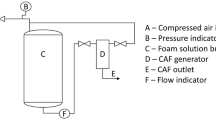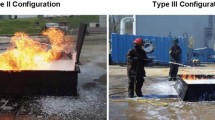Abstract
The experimental program described in this paper sought to assess the suitability of the small scale DEF(AUST)5706 standard for measuring the suppression and burnback performance of Class B foams on pool fires. DEF(AUST)5706 is an Australian Defence standard mandatory for use by the Australian Navy, Army and Air Force. The test protocol required the measurement of the 3/4 control, extinguishment and 1/3 burnback times for a circular pan of aviation gasoline (AVGAS 100/130), 0.28 m2 in surface area. The test program involved compressed-air foams (CAF) and aspirated foams of two expansion ratios, and employed two AFFF formulations: a 6% telomer concentrate and, to obtain base-line measurements, 3% PFOS FC-600 concentrate which was manufactured by the 3 M company prior to the PFOS phase out. At lower expansion (7:1), the aspirated and compressed-air foams demonstrated similar fire control performance, whilst more expanded (9:1) CAF was generally more efficient at extinguishing, but less efficient in controlling the fire. CAF formed a better seal over the fuel surface and at the hot pan walls, and these foams performed noticeably better than aspirated foam against fuel re-ignition. The paper links these observations with the underlying distributions of bubble sizes, which were measured and fitted to modified Rosin/Rammler cumulative volume distribution functions. We propose that a modified version of DEF(AUST)5706 be adopted as a universal small-scale test protocol.







Similar content being viewed by others
References
Lattimer B. Y., Trelles J. “Foam spread over a liquid pool”, Fire Safety J 42 (2007) 249-264.
Persson B, Lönnermark A, Persson H, Mulligan D, Lancia A, Demichela M (2001) FOAMSPEX: large scale foam applications—modelling of foam spread and extinguishment. SP Report 13
Dlugogorski BZ, Kennedy EM, Schaefer TH, Vitali J (2002) What properties matter in fire-fighting foams? In: Proceeding of 2nd NRIFD symposium, Tokyo, pp 57–78.
DEF(AUST)5706 (2003) Foam, liquid fire extinguishing; 3 percent and 6 percent concentrate specification, Commonwealth of Australia, Australian Defence Standard.
Lefebvre A. H., Atomization and Sprays, Hemisphere Publishing Corporation, New York, 1989.
Magrabi S. A., Dlugogorski B. Z., Jameson G. J. “Bubble size distribution and coarsening of aqueous foams” Chem Eng Sci 54 (1999) 4007-4022.
Defence Standard 42–40 (2002) Foam Liquids, Fire Extinguishing (Concentrates, Foam, Fire Extinguishing), Issue 2, UK Ministry of Defence.
Gardiner B. S., Dlugogorski B. Z., Jameson G. J. “Yield stress measurements of aqueous foams in the dry limit” J Rheol 42 (1998) 1437-1450.
Gardiner B. S., Dlugogorski B. Z., Jameson G. J. “The steady shear of three-dimensional wet polydisperse foams” J Non-Newtonian Fluid Mech 92 (2000) 151-166.
Lattimer B. Y., Hanauska C. P., Scheffey J. L., Williams F. “The use of small-scale test data to characterize some aspects of fire fighting foam for suppression modelling”, Fire Safety J 38 (2003) 117-146.
Magrabi SA, Dlugogorski BZ, Jameson GJ (1992) The performance of aged aqueous foams for mitigation of thermal radiation. Dev Chem Eng Mineral Process 8(2000): 93–112
Persson H Fire extinguishing foams—resistance against heat radiation. SP Report 54, Boras
Tuve RL, Peterson HB (1950) A study of some mechanical foams and their use for extinguishing tank fires. NRL Report 3725
Magrabi S. A., Dlugogorski B. Z., Jameson G. J. “A comparative study of drainage characteristics of AFFF and FFFP compressed-air fire-fighting foams” Fire Safety J 37 (2002) 21-52.
Acknowledgements
The authors show gratitude Mr Ted Schaefer of Solberg Asia Pacific for many insightful discussions and for partial support of the test program. We also thank Warrant Officer Greg Brown and Flight Sergeant Ross Fitzpatrick of the Royal Australian Air Force for their assistance.
Author information
Authors and Affiliations
Corresponding author
Additional information
This paper was presented at Suppresion and Detection Research and Application: A Technical Working Conference (SUPDET 2008), March 2008, Orlando, Florida, USA.
Rights and permissions
About this article
Cite this article
Laundess, A.J., Rayson, M.S., Dlugogorski, B.Z. et al. Small-Scale Test Protocol for Firefighting Foams DEF(AUST)5706: Effect of Bubble Size Distribution and Expansion Ratio. Fire Technol 47, 149–162 (2011). https://doi.org/10.1007/s10694-009-0136-2
Received:
Accepted:
Published:
Issue Date:
DOI: https://doi.org/10.1007/s10694-009-0136-2




